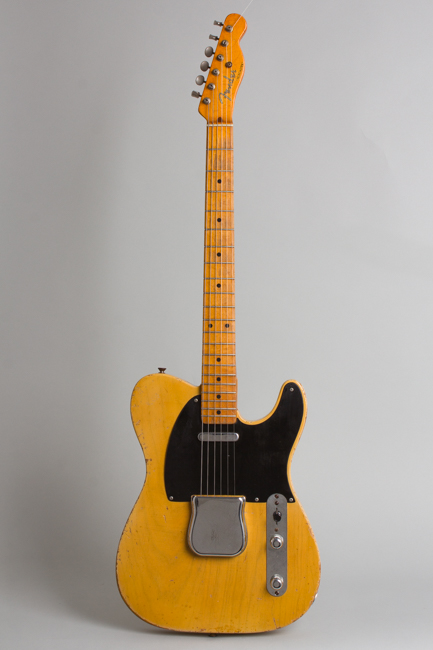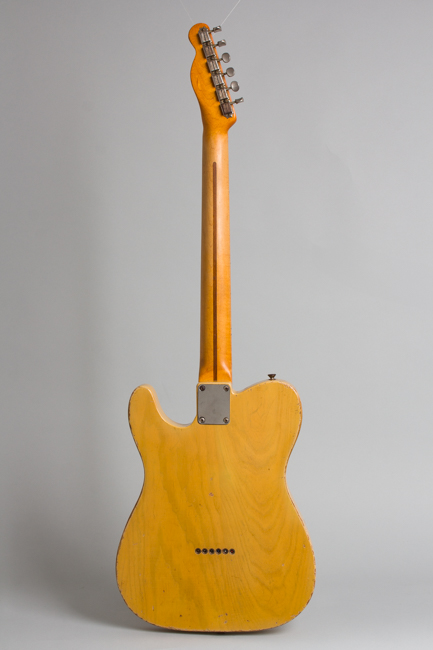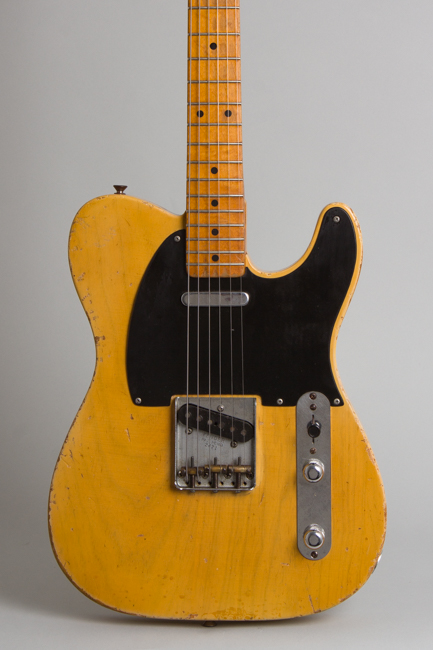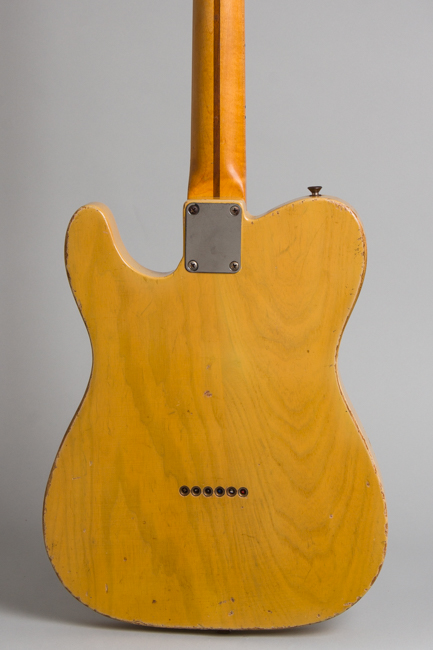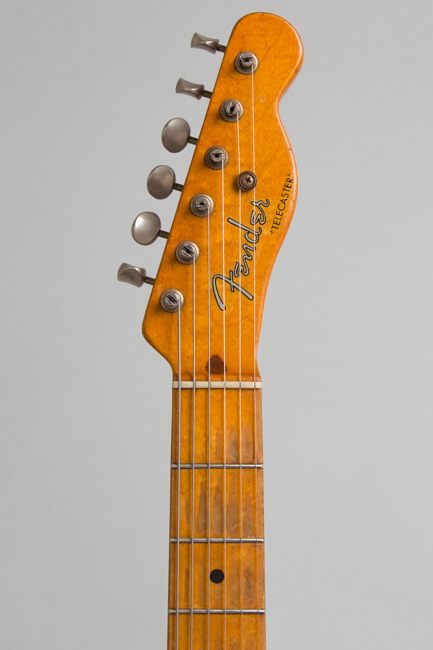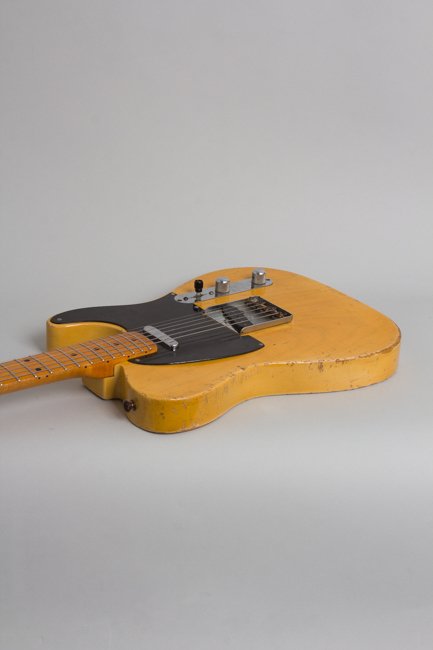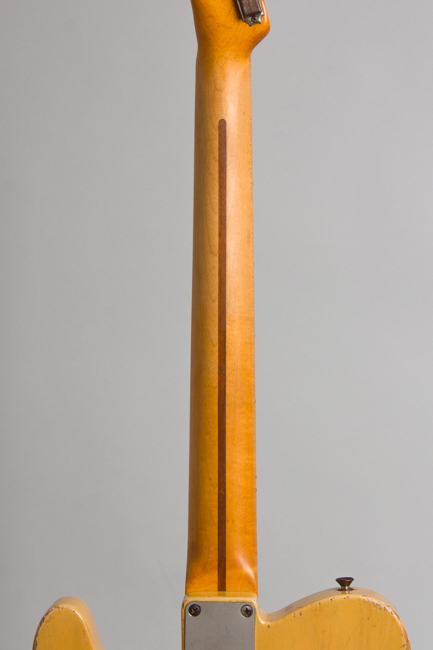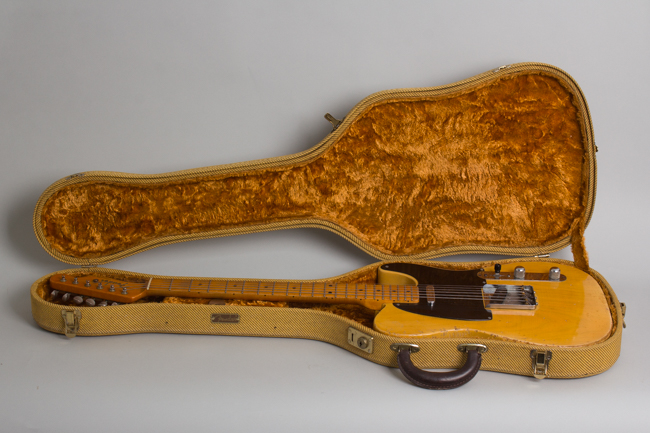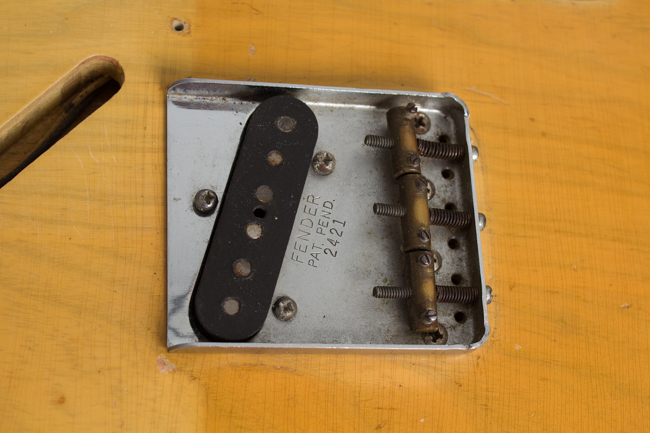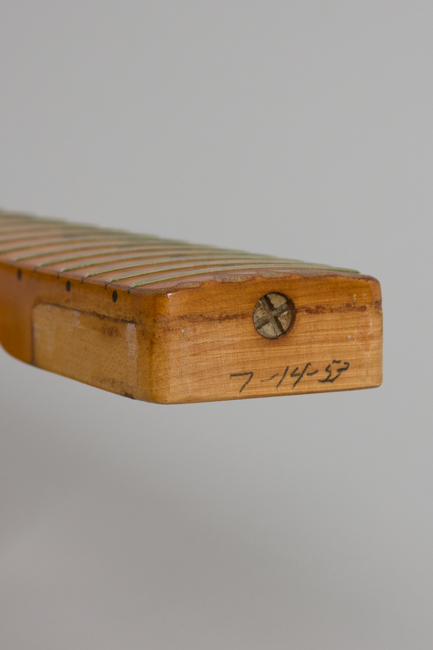Fender Telecaster Solid Body Electric Guitar (1953)
This item has been sold.
Item # 12780
Prices subject to change without notice.
Fender Telecaster Model Solid Body Electric Guitar (1953), made in Fullerton, California, serial # 2421, Blonde lacquer finish, ash body, maple neck, tweed hard shell case.
This is a somewhat played-in but still beautiful original "Blackguard" Telecaster, the guitar that put Leo Fender's company on the map. It was built in the summer of 1953, right after the company moved from their original cinder-block factory to a larger facility in Fullerton, California and retains all the classic '52 Tele features. The one-piece maple neck, aged "butterscotch" blonde-finished ash body, lacquered black fiber pickguard, brass bridge saddles, and of course the original black-bobbin hand wound pickups with a sound for the ages are all present and accounted for.
This guitar carries serial number 2421 stamped into the bridgeplate, a fairly early number for mid-'53 but these were never actually issued in sequence. Arlen Roth's famous 1953 Tele is #2426. The neck dated 7-14-53 in pencil on the heel, the body carries a date mark 6-18-53 in the neck pocket, with Taddeo Gomez' "TAD" marking. Both pot date codes are at least partially obscured but the pots and wiring remain original. The screws are Phillips-head as is customary for mid-1953; the bridge has its brass saddles notched under the outside ends to make lower action setting easier, another 1953 refinement.
This guitar has been played but not abused since it was shipped out in 1953 remaining original except for a recent refret and an ancient clear overfinish to the neck only. The maple neck has been neatly refretted with wire and there is a very old coating of clear lacquer on the neck from a previous job, now partially worn through again on the back and the fingerboard. This appears to have been done while the neck was attached to the body and without dismounting the tuners! The neck itself is very comfortable with a round-backed profile, a bit less thick in the "throat" in the lower positions than some '53s, with more material dressed away on the sides.
The early-style wiring rig, unlike many, has never been re-wired to the "modern" Telecaster switching scheme. As originally set up there is a "deep bass" capacitor on the neck pickup in switch position #1; position #2 is the neck pickup in normal mode, and #3 is the bridge pickup with a master tone control. The neck and bridge pickups can be combined by carefully lodging the selector between positions #2 and #3, which works better on this guitar than some we have had.
For many, 1952-3 are the classic Telecaster years, with the same look and feel of the earliest Fender Broadcaster and "No-Casters" from 1950-51 but more consistent production standards. Before the introduction of the Stratocaster in 1954 the Tele and Precision Bass were the company's most innovative products, already causing a revolution in playing styles and shaking up the guitar industry in a big way. The Telecaster was totally unique in look, feel, and sound, and became instantly popular, particularly with country players.
Some players and collectors consider the 1953 Telecaster the most desirable example of the model. The "butterscotch" blonde ash body and maple neck are subtly changed from the earlier examples, with the neck profile being slightly sleeker than "Broadcaster" standards. In his authoritative and beautiful book "The Blackguard" author Nachos Banos references this and states "There is something really magical about these mid-'53 butterscotch finishes". Many of the artists most since associated with "blackguard" Teles have used '53 models including Roy Buchanan, Danny Gatton, James Burton, Keith Richards, Albert Lee, and Red Volkaert.
Early Fender Telecasters of this period are considered one of the most collectable and historic of all electric guitars, and this is a very nice player-friendly example. At a bit over 8 Lbs. it is not the lightest Blackguard but has a very solid feel and a strong ringing sound even unplugged. The bridge pickup is truly superb with a cutting snarl that never gets harsh. This is a super cool example, not "Too clean to play" but retaining the original character of these now revered primal solidbodies.
Overall length is 38 3/4 in. (98.4 cm.), 12 5/8 in. (32.1 cm.) wide at lower bout, and 1 3/4 in. (4.4 cm.) in depth, measured at side of rim. Scale length is 25 1/2 in. (648 mm.). Width of nut is 1 5/8 in. (41 mm.)., 8.2 lbs.
Overall this is a beautifully plated-in example of an original '53 Blackguard showing some typical wear and tear but no notable repair except a refret and very old light neck overfinish, which is mostly worn away again. The previous owner apparently kept this guitar for decades and used it extensively "back in the day" so it is worn in but not abused.
The all-original thin lacquer body finish has ambered and checked lightly overall. It shows a varied collection of dings, dents, scratches and worn spots, especially to the edges as usual on Teles. The upper edge has some deeply dinged areas in an odd hashed pattern; we are not sure what caused this. The back has some dings, dents and scrapes, but not much belt buckle wear. There are some errant spots of lacquer that appear spilled on the bottom rim of the face and lower edge of the body. The original decal has some light puckering over the "Fender" portion from the added lacquer coat.
The finish on the back of the neck is smoothly worn down partially to the wood especially on the treble side. There are a few scattered dings and dents but nothing major. The fingerboard has a decent amount of wear through the finish lightly into the wood running up the treble side. The light overspray done to the neck and fingerboard has largely been subsequently worn away. The fret wire is slightly larger than '50s spec and quite comfortable; the bone nut is newer.
All hardware on the instrument is original, showing some typical wear. The bridge saddles and have some typical corrosion and discoloration but nothing is rusted hard and all adjustment screws are functional. The high e saddle spot has been buffed lightly, probably to get rid of a string notch. The original "ashtray" bridge cover is present, with some scratching on the top. Much of the original lacquer is worn off the face of the pickguard, and the area in the center has the imprint of something (a flag decal?) mostly visible under blacklight. The pickguard has warped up slightly on the upper edge.
Other than the newer frets and a few minor tweaks this instrument remains pretty much as it left Fullerton in fall 1953, with less wear from years of hard gigging behind it than many of these now show and none of the drastic modifications that befell way too many. It is a truly fantastic-sounding guitar, with a powerful bridge pickup that really sings. The guitar is housed in a more recent shaped tweed hard case, a splendid twang machine and serious piece of Fender -- and guitar -- history Overall Very Good + Condition.
This is a somewhat played-in but still beautiful original "Blackguard" Telecaster, the guitar that put Leo Fender's company on the map. It was built in the summer of 1953, right after the company moved from their original cinder-block factory to a larger facility in Fullerton, California and retains all the classic '52 Tele features. The one-piece maple neck, aged "butterscotch" blonde-finished ash body, lacquered black fiber pickguard, brass bridge saddles, and of course the original black-bobbin hand wound pickups with a sound for the ages are all present and accounted for.
This guitar carries serial number 2421 stamped into the bridgeplate, a fairly early number for mid-'53 but these were never actually issued in sequence. Arlen Roth's famous 1953 Tele is #2426. The neck dated 7-14-53 in pencil on the heel, the body carries a date mark 6-18-53 in the neck pocket, with Taddeo Gomez' "TAD" marking. Both pot date codes are at least partially obscured but the pots and wiring remain original. The screws are Phillips-head as is customary for mid-1953; the bridge has its brass saddles notched under the outside ends to make lower action setting easier, another 1953 refinement.
This guitar has been played but not abused since it was shipped out in 1953 remaining original except for a recent refret and an ancient clear overfinish to the neck only. The maple neck has been neatly refretted with wire and there is a very old coating of clear lacquer on the neck from a previous job, now partially worn through again on the back and the fingerboard. This appears to have been done while the neck was attached to the body and without dismounting the tuners! The neck itself is very comfortable with a round-backed profile, a bit less thick in the "throat" in the lower positions than some '53s, with more material dressed away on the sides.
The early-style wiring rig, unlike many, has never been re-wired to the "modern" Telecaster switching scheme. As originally set up there is a "deep bass" capacitor on the neck pickup in switch position #1; position #2 is the neck pickup in normal mode, and #3 is the bridge pickup with a master tone control. The neck and bridge pickups can be combined by carefully lodging the selector between positions #2 and #3, which works better on this guitar than some we have had.
For many, 1952-3 are the classic Telecaster years, with the same look and feel of the earliest Fender Broadcaster and "No-Casters" from 1950-51 but more consistent production standards. Before the introduction of the Stratocaster in 1954 the Tele and Precision Bass were the company's most innovative products, already causing a revolution in playing styles and shaking up the guitar industry in a big way. The Telecaster was totally unique in look, feel, and sound, and became instantly popular, particularly with country players.
Some players and collectors consider the 1953 Telecaster the most desirable example of the model. The "butterscotch" blonde ash body and maple neck are subtly changed from the earlier examples, with the neck profile being slightly sleeker than "Broadcaster" standards. In his authoritative and beautiful book "The Blackguard" author Nachos Banos references this and states "There is something really magical about these mid-'53 butterscotch finishes". Many of the artists most since associated with "blackguard" Teles have used '53 models including Roy Buchanan, Danny Gatton, James Burton, Keith Richards, Albert Lee, and Red Volkaert.
Early Fender Telecasters of this period are considered one of the most collectable and historic of all electric guitars, and this is a very nice player-friendly example. At a bit over 8 Lbs. it is not the lightest Blackguard but has a very solid feel and a strong ringing sound even unplugged. The bridge pickup is truly superb with a cutting snarl that never gets harsh. This is a super cool example, not "Too clean to play" but retaining the original character of these now revered primal solidbodies.
Overall length is 38 3/4 in. (98.4 cm.), 12 5/8 in. (32.1 cm.) wide at lower bout, and 1 3/4 in. (4.4 cm.) in depth, measured at side of rim. Scale length is 25 1/2 in. (648 mm.). Width of nut is 1 5/8 in. (41 mm.)., 8.2 lbs.
Overall this is a beautifully plated-in example of an original '53 Blackguard showing some typical wear and tear but no notable repair except a refret and very old light neck overfinish, which is mostly worn away again. The previous owner apparently kept this guitar for decades and used it extensively "back in the day" so it is worn in but not abused.
The all-original thin lacquer body finish has ambered and checked lightly overall. It shows a varied collection of dings, dents, scratches and worn spots, especially to the edges as usual on Teles. The upper edge has some deeply dinged areas in an odd hashed pattern; we are not sure what caused this. The back has some dings, dents and scrapes, but not much belt buckle wear. There are some errant spots of lacquer that appear spilled on the bottom rim of the face and lower edge of the body. The original decal has some light puckering over the "Fender" portion from the added lacquer coat.
The finish on the back of the neck is smoothly worn down partially to the wood especially on the treble side. There are a few scattered dings and dents but nothing major. The fingerboard has a decent amount of wear through the finish lightly into the wood running up the treble side. The light overspray done to the neck and fingerboard has largely been subsequently worn away. The fret wire is slightly larger than '50s spec and quite comfortable; the bone nut is newer.
All hardware on the instrument is original, showing some typical wear. The bridge saddles and have some typical corrosion and discoloration but nothing is rusted hard and all adjustment screws are functional. The high e saddle spot has been buffed lightly, probably to get rid of a string notch. The original "ashtray" bridge cover is present, with some scratching on the top. Much of the original lacquer is worn off the face of the pickguard, and the area in the center has the imprint of something (a flag decal?) mostly visible under blacklight. The pickguard has warped up slightly on the upper edge.
Other than the newer frets and a few minor tweaks this instrument remains pretty much as it left Fullerton in fall 1953, with less wear from years of hard gigging behind it than many of these now show and none of the drastic modifications that befell way too many. It is a truly fantastic-sounding guitar, with a powerful bridge pickup that really sings. The guitar is housed in a more recent shaped tweed hard case, a splendid twang machine and serious piece of Fender -- and guitar -- history Overall Very Good + Condition.
